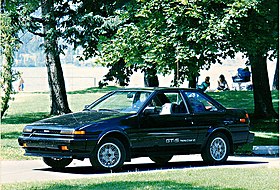
The Levin has fixed-headlights, and the Trueno has retractable headlights, both could be hatchback or coupe. The export model name Corolla covers both variations. The AE86 (along with the lower spec 1,452 cubic centimetres (1.452 L) AE85 and 1587 cc SR5 versions) was rear wheel drive (unlike the front wheel drive CE80, EE80 and AE82 models), and is among the last rear-drive cars of its type, at a time when most passenger cars were being switched to front-drive. In 1987, there was a limited edition model of the AE86 called "Black Limited" that served as a send-off model before the AE86 chassis was replaced later that year by the front wheel drive AE92 Corolla/Sprinter range.
In Japan, the AE86 was also known as the Hachi-Roku (ハチロク?), Japanese for "eight-six". In Japan, the Sprinter Trueno was exclusive to Toyota Japan dealerships called Toyota Vista Store, while the Corolla Levin was exclusive to Toyota Corolla Store. The word "trueno" is Spanish for thunder, and "levin" is Middle English for "lightning".
The AE86 later inspired the Toyota 86 (also badged as the Scion FR-S and Subaru BRZ).
The AE86 was available with a fuel-injected 4-cylinder twin-cam 1587 cc 4A-GE engine in Japan and Europe which was also used in the first-generation Toyota MR2 (AW11). This engine had a maximum gross power output of 130 PS (128 bhp; 96 kW) and 110 lb·ft (150 N·m) of torque in standard form, though it was later down-rated to 120 PS (118 bhp; 88 kW) and 105 lb·ft (142 N·m) in net output. The AE86 came with a 5-speed manual gearbox, and later came with the option of an automatic. The 4A-GE engines used in the AE86 and AW11 were equipped with T-VIS (Toyota Variable Intake System). The AE86 had an optional LSD.
In North America, a modified 4A-GEC engine was used to comply with California emissions regulations. Power was rated at 112 bhp (84 kW), and 96 lb·ft (136 Nm) of torque.
The AE86 used ventilated disc brakes. The car was equipped with a MacPherson strut style independent suspension at the front and a four-link live axle with coil springs for the rear. Stabilizer bars were present at both ends.
Higher- spec AE86 models known as the GTS featured the DOHC 4AGE, 4 wheel disc brakes, color matched bumpers, front lower bumper surround had a much more sporty and pronounced lip, door panels were moulded, tachometer redline is around 7,500, wrapped steering wheel, seats had leather wrapped tops ( front seats are completely different from SR5), optional LSD, and aluminium wheels, chassis code in the VIN is AE88 (for North American market cars).
Lower-spec American AE86 SR5 models used the 1587 cc 4A-C SOHC unit, The SR5 rear end was a non LSD with drum brakes. The SR5 model also had a softer suspension, and small styling and interior changes such as seats, gauge cluster, door panels, un-painted front and rear bumpers, and the lower part of the front bumper surround is shorter and flat, and its chassis code in the vin differs as well being AE86 for the SR5 model (for North American market cars)
Models equipped with the 4A-GE engine received a 6.7" rear differential, while 4A-U, and 4A-C models received a smaller, weaker, 6.38" rear differential.
The AE86 SR5 (4A-C equipped) had an optional automatic transmission, though the GT-S model (with the 4A-GE DOHC engine) only came with a standard 5-speed manual gearbox.
One of the staff who was behind the car's engineering work was Nobuaki Katayama, who would later head the company's motorsport department and who would become chief engineer of the Altezza project a decade later. An article in Car Magazine in April 1999, stated he has a photo of an AE86 hung in his office.
Body styles
Variety of AE86s at 2004 Hachiroku.com.au Annual AE86 Meet-Up in Melbourne, Australia.
| Manufacturer | Toyota |
|---|---|
| Also called | Toyota Corolla, Toyota Sprinter |
| Production | May 1983[1]–1987 |
| Assembly | Toyota City, Japan |
| Body and chassis | |
| Class | Sport compact |
| Body style | 2-door coupé, 3-door hatchback |
| Layout | Front-engine, rear-wheel drive |
| Related | Toyota AE85 |
| Powertrain | |
| Engine | 1.6 L 4A-C I4 1.6 L 4A-GEU I4, 1.6 L 4A-GEC I4 |
| Transmission | T50 5-speed manual, A42DL 4-speed automatic |
| Dimensions | |
| Wheelbase | 2,400 mm (94.5 in) |
| Length | 4,200 mm (165.5 in) |
| Width | 1,630 mm (64.0 in) |
| Height | 1,340 mm (52.6 in) |
| Curb weight | 923–1,089 kg (2,035–2,400 lb) |
| Chronology | |
| Successor | Toyota Corolla E90 |

No comments:
Post a Comment